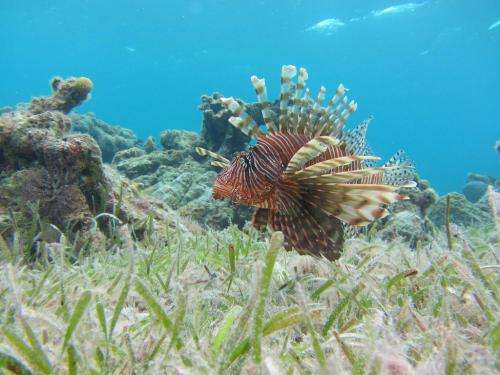Controlling lion's share of lionfish

(Phys.org) —Three Simon Fraser University researchers and a recent graduate have co-authored the first study to demonstrate that beating back the fearsome lionfish will rejuvenate threatened native fish in the Bahamas and elsewhere.
The journal Ecological Applications has just published the researchers' findings in a paper called Linking removal targets to the ecological effects of invaders: a predictive model and field test.
Stephanie Green, the lead author and an SFU doctoral biology graduate; SFU biologists Isabelle Côté (Green's thesis supervisor) and Nick Dulvy; Andrew Cooper; associate professor, SFU School of Resource and Environmental Management and Oregon State University scientists conducted the study.
The researchers based their conclusions on ecological computer modeling results and 18 months of field-testing. They found that reducing lionfish numbers at the sites they studied by 75 to 95 per cent precipitated a 50 to 70 per cent increase in native prey fish.
The researchers isolated a range of numbers that specified the tipping point of lionfish populations beyond which native prey fish populations will either decline or bounce back. The numerical range was discovered while analyzing lionfish and native prey fish population dynamics in 24 natural coral reefs near Eleuthera Island in the Bahamas. Divers used nets and spears to remove lionfish that invaded the shallow water-based reefs.
"Many researchers in the Caribbean, Gulf of Mexico and U.S. Atlantic coastal regions are removing lionfish, but there has been little research verifying whether control is effective at recovering and protecting native fish," notes Côté.
"Our study is the first to show that control can be effective and that native fish will return to reefs once lionfish are removed. We are also the first to provide a way to determine how much lionfish control is needed."
Green, who graduated from SFU last summer and is now a marine ecologist at Oregon State University's College of Science, adds their discovery is applicable to rehabilitating any threatened marine species.
"You don't need to completely eradicate an invasion in order to protect and recover native fish species," explains Green. "In invasions that are already spread over large areas, such as lionfish, local actions can effectively protect pockets of habitat where native species can thrive. This same approach could be used for other marine invasions, such as the European green crab off the west coast of Vancouver Island."
Native to the tropical Indian and Pacific oceans, lionfish invade and devour native fish in a wide swath of oceans—the Bahamas, the Caribbean, Gulf of Mexico, the American western Atlantic coast, north to Bermuda and the North Carolina coast and south to Venezuela.
Their consumption of highly prized, commercially fished and aesthetically idolized species, such as the Nassau grouper and Yellowtail snapper, is devastating multi-million dollar fishing and tourism industries.
Background:
Lionfish are extremely popular in U.S. aquarium trade. According to the researchers, they most likely got into the Atlantic through release from the aquarium trade into South Florida waters, starting in the 1980s.
With venomous spines and no natural predators in the Atlantic Ocean, this aggressive fish has been known to devour anything smaller than it, including fish, shrimp, crabs and octopus.
In another study the team showed that lionfish reduced native prey species by an average of 65 per cent—and on some sites up to 95 per cent—in just two years in the Bahamas.
More information: "Linking removal targets to the ecological effects of invaders: a predictive model and field test." Stephanie J. Green, Nicholas K. Dulvy, Annabelle L. M. Brooks, John L. Akins, Andrew B. Cooper, Skylar Miller, and Isabelle M. Côté, Ecological Applications
Journal information: Ecological Applications
Provided by Simon Fraser University



















